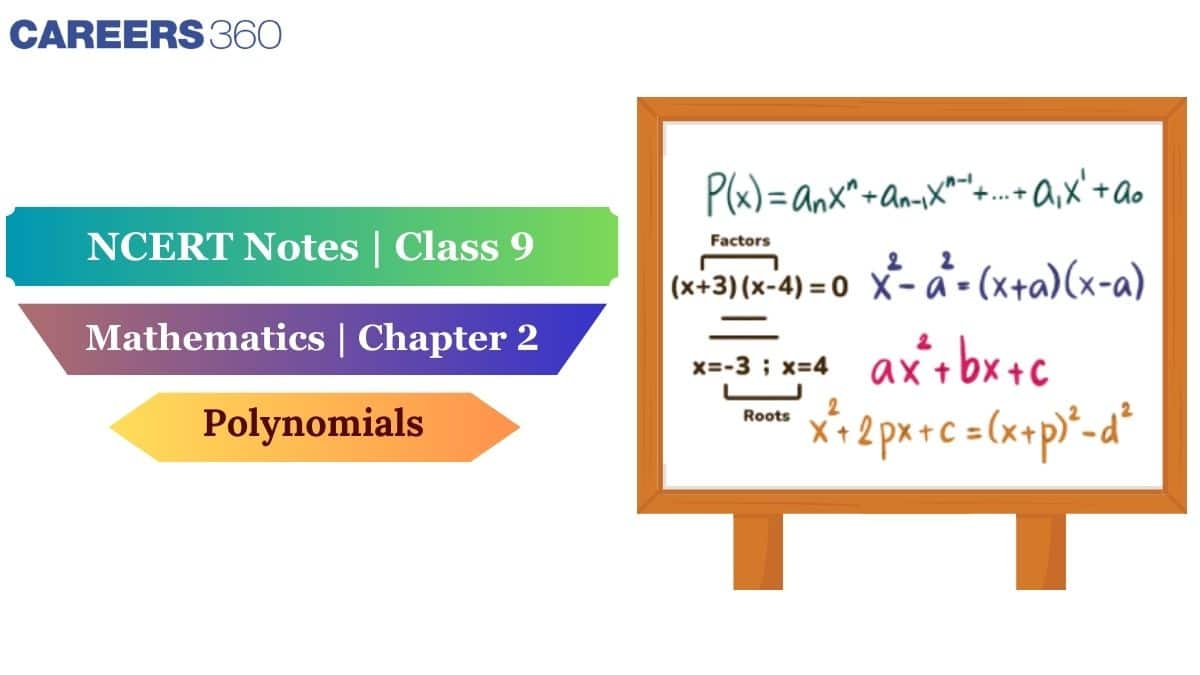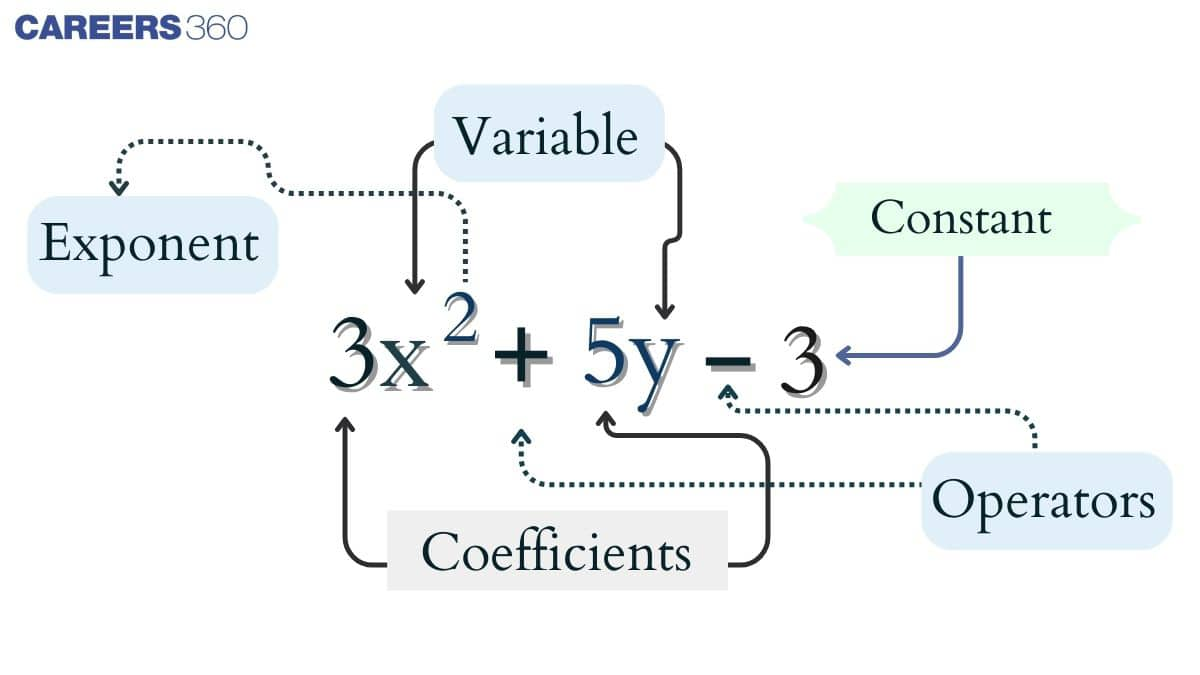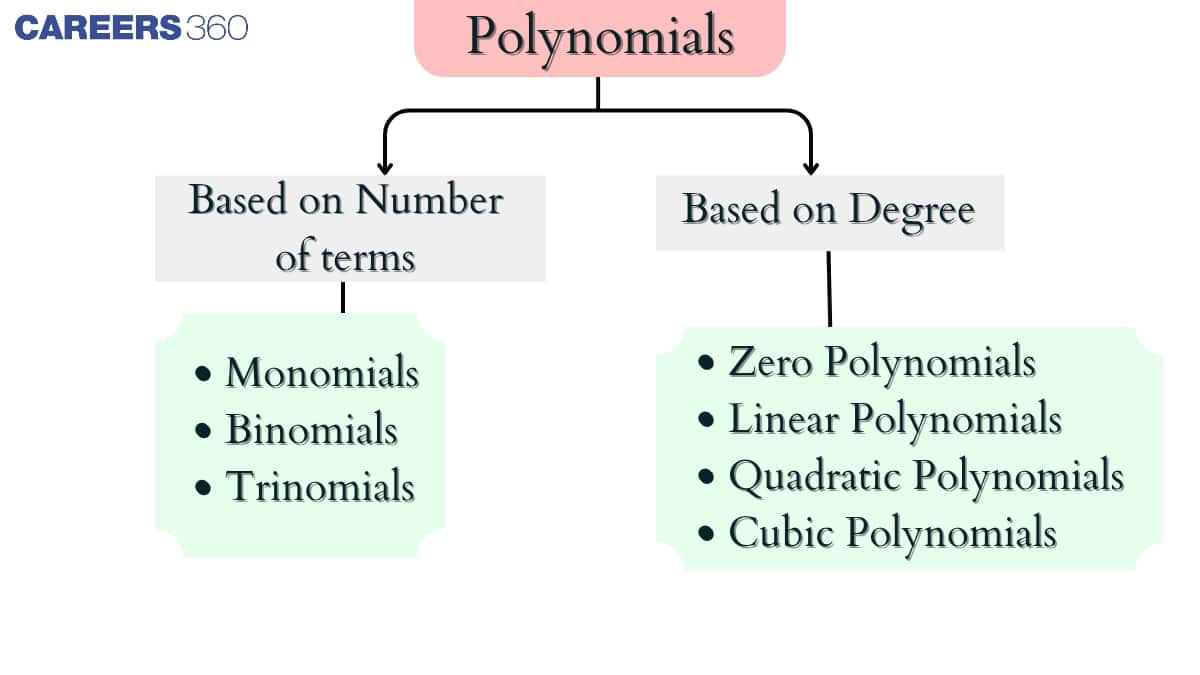NCERT Class 9 Maths Chapter 2 Notes – Polynomials (PDF & Summary)
Polynomials are more than just expressions; they're the building blocks of algebra! A polynomial is an algebraic expression that is made up of variables and constants. In polynomial expressions, variables are also known as indeterminants and coefficients. A polynomial can have a single or multiple variables. A polynomial expression with more than one variable comprises the arithmetic operations like addition, subtraction and multiplication. These arithmetic operations define the relationship between variables and constants. Polynomials have many applications in different fields such as science, engineering, and economics as a fundamental tool for analysing and solving problems. Polynomials are also used in medicine, as well as in the prediction and optimisation of complex issues. These NCERT class 9 Maths chapter 2 notes are a great source to review all the learned concepts and feel more confident before exams. Curated by Careers360 experts, these NCERT notes strictly follow the updated NCERT syllabus, ensuring focused and effective learning.
This Story also Contains
- Class 9 Polynomials Notes PDF – Download Free Study Material
- Polynomials Class 9 Notes
- How to Use the Polynomials Class 9 Notes Effectively?
- Polynomials Class 9 Notes: Previous Year Question and Answer
- NCERT Class 9 Maths Notes – Chapter-Wise Links

These NCERT notes cover basic definitions of polynomials, types of polynomials, algebraic expressions, the factor theorem, and the remainder theorem. It also includes all the required formulae, topics and subtopics related to polynomials. In addition, it also includes all important formulas of algebraic identities. CBSE Class 9 chapter Polynomials also includes the geometrical representation of the zeroes of polynomials. These NCERT class 9th maths notes help the students to understand the concepts of each chapter with the help of definitions, formulas, and examples. Find everything in one place – NCERT Books, Solutions, Syllabus, and Exemplar Problems with Solutions – in this NCERT article.
Also, read,
Class 9 Polynomials Notes PDF – Download Free Study Material
Students who wish to access the Polynomials Class 9 Maths notes can click on the link below to download the entire notes in PDF.
Polynomials Class 9 Notes
Careers360 brings you NCERT Class 9 Maths Chapter 2 Polynomials notes, carefully prepared by subject experts to simplify your studies and help in exams.
Polynomials
Polynomials are an algebraic expression that has one or more variables with non-negative exponents. A polynomial can be represented by $P(x)$ where $P$ is called a polynomial in $x$ and the exponent of $x$ is called the highest degree of $x$. As shown in the figure below.

Example: 2x + 1, 3xy, 3x3 + 2x2 + x + 1, x + y + z etc.
Terms
An expression that is a part of the polynomial expression is called a term.
Example: 4x2 + 2x + 2
Where 4x2, 2x and 2 are the terms of a polynomial expression.
Coefficient
A factor that multiples a variable or a term is called a coefficient. A coefficient can be a whole number, a fraction or a decimal, and these numbers can be negative or positive.
Types of Polynomials
Based on the degrees and terms that a polynomials have, polynomials can be classified into two categories:
1. Number of terms
2. Degree of polynomials

Based On the Number Of Terms
A polynomial expression can have one or more terms, and according to the number of terms, polynomials are as follows -
1. A polynomial with only one term is called a monomial.
Example: $4x$, $7pq$, $9p^2$
2. A polynomial with only two unlike terms is called a binomial.
Example: $4x + 1$, $7y^2$ + $3$
3. A polynomial with only three unlike terms is called a trinomial.
Example: $4y^2$ + $2y$ - $2$
Based On the Degree Of Polynomials
1. A polynomial with 0 as a degree is called a zero or constant polynomial.
Example: $2x^0$, $5y^0$
2. A polynomial with 1 as a degree is called a linear polynomial.
Example: $3x$ + $1$, $4y$ + $5$
3. A polynomial with 2 as a degree is called a quadratic polynomial.
Example: $5x^2$ + $3x$ + $1$
4. A polynomial that has 3 as a degree is called a cubic polynomial.
Example: $7x^3$ + $5x$ - $2$
Polynomials in One Variable
A polynomial expression that has one type of variable in the entire expression is known as a polynomial in one variable.
Example: 8x2 + 4x + 2, 5y + 2, 6z.
Zeros of A Polynomial
The value of the variable that makes polynomials equal to zero is called the zeros of a polynomial.
Example: For the polynomial $p(y)$ = $x^2$ - $9$,
the zeros are $x = 3$ and $x = -3$,
because $p(3)$ = $3^2$ - $9$ = $0$ and p(-3) = (-3)2 - 9 = 0
Finding Zeros of Polynomials for Linear Equations
The standard form of a linear equation is P(x) = ax + b, and for this equation, the formula for finding the zeros is as follows:
Zero of Polynomial (x) = $\frac{-\text{Constant}}{\text{ Coefficent of x}}$
Example: Find the zero of a polynomial P(x) = 2y - 8
Here,
Constant = 8
Coefficient = 2
Zero of Polynomial (y) = $\frac{-\text{Constant}}{\text{ Coefficent of y}}$
Zero of Polynomial (y) = $\frac{-8}{2}$
Zero of Polynomial (y) = $-4$
Finding Zeros of Polynomials for Quadratic Equations
The standard form of a quadratic equation is ax2 + bx + c = 0, where a, b and c are constants. Therefore, the formula for finding zeros of quadratic equations is:
$X$ = $\frac{-b \pm \sqrt{b^2 - 4ac}}{2a}$
Example: Find the zeros of a polynomial of the quadratic equation 5x2 + 4x + 1 = 0.
After comparing the question equation with the standard quadratic equation ax2 + bx + c = 0, we get,
a = 5
b = 4
c = 1
And,
$X$ = $\frac{-b \pm \sqrt{b^2 - 4ac}}{2a}$
After putting the values in the formula, we get,
$⇒X$ = $\frac{-4 \pm \sqrt{4^2 - 4 × 5 × 1}}{2 × 5}$
$⇒X$ = $\frac{-4 \pm \sqrt{16 - 20}}{10}$
$⇒X$ = $\frac{-4 \pm \sqrt{-4}}{10}$
$⇒X$ = $\frac{-4 \pm {(-2)}}{10}$
Therefore, $X$ = $-\frac{3}{5}$ and $X$ = $-\frac{1}{5}$
Relationship Between Zeros And Coefficients Of a Polynomial
For quadratic Polynomials, the standard quadratic equation is:
ax2 + bx + c and let α and β be the roots of the standard quadratic equation, then,
Sum of the zeroes (α + β) = $-\frac{b}{a}$ or $-\frac{\text{Coeffiecient of x}}{\text{Coeffiecinet of x}^2}$
Product of the zeroes (αβ) = $\frac{c}{a}$ or $\frac{\text{Constant term}}{\text{Coefficient of x}^2}$
Example: x2 + 7x + 10
After comparing the question equation with the standard quadratic equation ax2 + bx + c = 0, we get,
b = 7
a = 1
c = 10
Sum of the zeroes (α + β) = $-\frac{7}{1}$
Product of the zeroes (αβ) = $\frac{10}{1}$
For Cubic Polynomials:
Let α, β and γ be the roots of a cubic polynomial ax3 + bx2 + cx + d, then
α + β + γ = $-\frac{b}{a}$
αβ + βγ + γα = $\frac{c}{a}$
αβγ = $-\frac{d}{a}$
Example: Find zeros for the polynomial equation P(x) = 3x3 + 2x2 + x + 2
After comparing the equation with standard polynomial equation ax3 + bx2 + cx + d we get,
a = 3
b = 2
c = 1
d = 2
α + β + γ = $-\frac{b}{a}$
αβ + βγ + γα = $\frac{c}{a}$
αβγ = $\frac{-d}{a}$
After putting in the values, we get,
α + β + γ = $-\frac{2}{3}$
αβ + βγ + γα = $\frac{1}{3}$
αβγ = $-\frac{2}{3}$
Remainder Theorem
It is a fundamental method that is used to determine the remainder of the polynomials when a polynomial is divided by a linear expression. If P(x) is a polynomial with degree greater than or equal to 1 and if the polynomial is divided by (x-a), then P(a) is called the remainder. Here, (x-a) is called the divisor of the polynomial P(a) is equal to 0. This is applied in factorising polynomials.
The general formula is as follows:
${P(x)}$ = $(x - a) Q(x) + P(a)$
Where,
P(x) = Polynomial equation
Q(x) = Quotient
P(a) = Remainder
(x - a) = Divisor
Example: If P(x) is 6x2 + 5x + 1 is divided by x - 2 and the quotient is 6x + 17, then the remainder will be 35.
Here, x - 2 is a divisor, and we know that,
x - a = 0,
Therefore, x - 2 = 0
x = 2
By placing the values in the P(x), we get,
= 6 × (2)2 + 5 × 2 + 1
= 24 + 10 + 1
= 35
Factor Theorem
When the polynomials are completely divisible, the factor theorems are used. It is used for factoring polynomials or for finding the roots.
Proof Using Remainder Theorem
Let P(x) be a polynomial which is divided by (x - a), then P(a) = 0.
According to the remainder theorem,
P(x) = (x - a) × Q(x) + P(a)
Since, P(a) = 0, then
P(x) = (x - a) × Q(x) + P(a)
It is proved that (x - a ) is a factor of the polynomial P(x).
Factorisation of Polynomials
The process of defining the polynomials as the product of two or more terms is known as the factorisation of polynomials.
Example: Find the roots of the polynomial P(x) = 6x2 + 17x + 5 using the factorisation method.
P(x) = 6x2 + 17x + 5
⇒ 6x2 + 15x + 2x + 5 = 0
⇒ 3x(2x + 5) + 1(2x + 5) = 0
⇒ (2x + 5), (3x + 5)
⇒ x = $\frac{-5}{3}$, $\frac{-5}{2}$,
Algebraic Identities
In polynomials, some algebraic identities are given that are valid for certain values. Algebraic identities are equations and identities are as follows:
1. $(x+y+z)^2=x^2+y^2+z^2+2 x y+2 y z+2 z x$
2. $(x+y)^3=x^3+y^3+3 x y(x+y)$
3. $(x-y)^3=x^3-y^3-3 x y(x-y)$
4. $x^3+y^3+z^3-3 x y z=(x+y+z)\left(x^2+y^2+z^2-x y-y z-z x\right)$
How to Use the Polynomials Class 9 Notes Effectively?
Polynomials become easier to understand when we study them one step at a time. This chapter is all about understanding terms, zeroes, and identities in a clear and concise manner. When we revise regularly, the concepts stay in our minds for a long time. Here are some more points on how these notes are important.
- Begin by reading about the basic ideas, such as polynomials in one variable and zeroes of a polynomial, then examine the examples to see how each concept is applied.
- Write small summaries of algebraic identities and factorisation methods so we can revise them quickly before solving questions.
- While you solve textbook problems, keep the NCERT Class 9 Maths chapter 2 notes open so you can understand your mistakes and how to fix them.
- Build a strong base by using the NCERT Class 9 Maths chapter 2 notes, as higher classes require these ideas again, especially in algebra and factorisation chapters.
Polynomials Class 9 Notes: Previous Year Question and Answer
Listed below are important previous year question answers for NCERT Class 9 Maths Chapter 2 Polynomials compiled from different board exams.
Question 1:
If $\frac{1}{x}+x=4$, then find $\frac{1}{x^2}+x^2$.
Solution:
$\frac{1}{x}+x=4$
squaring both sides, we get,
⇒ $(\frac{1}{x}+x)^2=4^2$
⇒ $\frac{1}{x^2}+2×\frac{1}{x}×x+x^2=16$
⇒ $\frac{1}{x^2}+x^2=16-2$
⇒ $\frac{1}{x^2}+x^2=14$
Hence, the correct answer is 14.
Question 2:
If 4x2 + y2 = 40 and xy = 6, then find the value of 2x + y.
Solution:
Given: 4x2 + y2 = 40 and xy = 6
(2x + y)2 = 4x2 + y2 + 2 × 2x × y
⇒ (2x + y)2 = 40 + 4 × 6
⇒ (2x + y)2 = 64
$\therefore$ 2x + y = 8
Hence, the correct answer is 8.
Question 3:
If $a-\frac{1}{a-5}=10$, then the value of $(a-5)^3-\frac{1}{(a-5)^3}$ is:
Solution:
$a-\frac{1}{a-5}=10$ .............(1)
Subtract 5 from equation (1) on both sides
$(a-5)-\frac{1}{a-5}=10-5$
⇒ $(a-5)-\frac{1}{a-5}=5$
Now, take $(a - 5) = x$
So, the equation becomes
⇒ $x-\frac{1}{x}=5$
Cubing both sides
⇒ $x^3-\frac{1}{x^3}-3(x-\frac{1}{x}) = 125$
⇒ $x^3-\frac{1}{x^3} = 125+3(5)$
⇒ $x^3-\frac{1}{x^3} = 140$
Hence, the correct answer is 140.
NCERT Class 9 Maths Notes – Chapter-Wise Links
We at Careers360 compiled all the NCERT class 9 Maths notes in one place for easy student reference. The following links will allow you to access them.
|
NCERT Notes Class 9 Maths Chapter 2 Polynomials |
|
NCERT Notes Class 9 Maths Chapter 4 Linear Equations in Two Variables |
|
NCERT Notes Class 9 Maths Chapter 5 Introduction To Euclid’s Geometry |
|
NCERT Notes Class 9 Maths Chapter 11 Surface Areas and Volumes |
NCERT Solutions for Class 9
Students must check the NCERT solutions for Class 9 Maths and Science given below:
NCERT Exemplar Solutions for Class 9
Students must check the NCERT exemplar solutions for Class 9 Maths and Science given below:
NCERT Books and Syllabus
Before the start of a new academic year, students should refer to the latest syllabus to determine the chapters they’ll be studying. Below are the updated syllabus links, along with some recommended reference books.
Frequently Asked Questions (FAQs)
A polynomial is an algebraic expression consisting of variables, coefficients, and exponents combined using addition, subtraction, or multiplication, such as 2x² + 3x + 5
The degree of a polynomial is the highest power of the variable in the expression.
A zero of a polynomial is a value of the variable that makes the polynomial equal to zero, i.e., if p(a)=0, then a is a zero of p(x).
Algebraic identities are equations that hold for all values of variables, such as
(a + b)² = a² + 2ab + b²
Students can download free PDFs of Polynomials Class 9 Notes from trusted educational websites, such as Careers360, for quick offline study.
Courses After 12th
Applications for Admissions are open.
As per latest syllabus. Physics formulas, equations, & laws of class 11 & 12th chapters
JEE Main Important Chemistry formulas
Get nowAs per latest syllabus. Chemistry formulas, equations, & laws of class 11 & 12th chapters
JEE Main high scoring chapters and topics
Get nowAs per latest 2024 syllabus. Study 40% syllabus and score upto 100% marks in JEE
JEE Main Important Mathematics Formulas
Get nowAs per latest syllabus. Maths formulas, equations, & theorems of class 11 & 12th chapters
